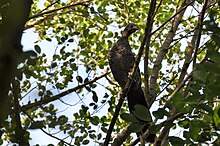
The grey-headed chachalaca is a member of an ancient group of birds of the family Cracidae, which includes chachalacas, guans, and curassows. It is found from Honduras to Colombia.

The little chachalaca is a bird in the family Cracidae, the chachalacas, guans, and curassows. It is found in Brazil, French Guiana, Suriname, Guyana, Venezuela and possibly Colombia.

The scale-throated hermit is a species in the hummingbird family Trochilidae. It is found in Argentina, Brazil, and Paraguay.

The sickle-winged guan is a species of bird in the chachalaca, guan, and curassow family Cracidae. It is found in Bolivia, Colombia, Ecuador, and Peru.

The crestless curassow is a species of bird in the family Cracidae, the chachalacas, guans, and curassows. It is found in Brazil, Colombia, Guyana, and Venezuela.

The razor-billed curassow is a species of bird in the family Cracidae, the chachalacas, guans, and curassows. It is found in Bolivia, Brazil, Colombia, and Peru.

The nocturnal curassow is a species of bird in the family Cracidae, the chachalacas, guans, and curassows. It is found in Brazil, Colombia, Ecuador, Peru, and Venezuela.

The Chaco chachalaca is a species of bird in the family Cracidae, the chachalacas, guans, and curassows. It is found in Argentina, Bolivia, Brazil, Paraguay, and possibly Uruguay.

The rufous-headed chachalaca is a species of bird in the family Cracidae, the chachalacas, guans, and curassows. It is found in Colombia, Ecuador, and Peru.

The chestnut-winged chachalaca is a species of bird in the family Cracidae, the chachalacas, guans, and curassows. It is endemic to Colombia.

The speckled chachalaca is a species of bird in the family Cracidae, the chachalacas, guans, and curassows. It is found in Bolivia, Brazil, Colombia, Ecuador, and Peru.

The white-bellied chachalaca is a species of bird in the family Cracidae, the chachalacas, guans, and curassows. It is found in El Salvador, Guatemala, Honduras, Mexico, and Nicaragua.

The West Mexican chachalaca is a species of bird in the family Cracidae, the chachalacas, guans, and curassows. It is endemic to Mexico.

The buff-browed chachalaca is a species of bird in the family Cracidae, the chachalacas, guans, and curassows. It is endemic to Brazil.

The rufous-bellied chachalaca is a species of bird in the family Cracidae, the chachalacas, guans, and curassows. It is endemic to western Mexico.

The Marail guan or Cayenne guan is a species of bird in the family Cracidae, the chachalacas, guans, and curassows. It is found in Brazil, French Guiana, Guyana, Suriname, and Venezuela.

The rusty-margined guan is a species of bird in the family Cracidae, which includes the chachalacas, guans, and curassows. It is found in Argentina, Bolivia, Brazil, and Paraguay.

The Chocó poorwill is a species of nightjar in the family Caprimulgidae. It is found in Colombia and Ecuador.

The East Brazilian chachalaca is a species of bird in the family Cracidae, the chachalacas, guans, and curassows. It is endemic to eastern Brazil.

The chestnut-headed chachalaca is a bird in the family Cracidae, the chachalacas, guans, and curassows. It is endemic to Brazil.























